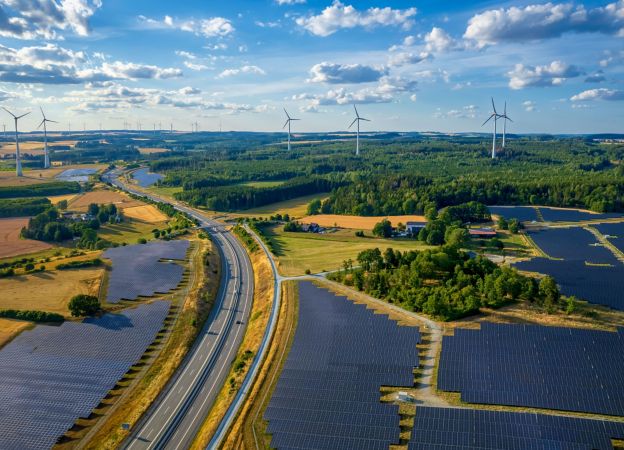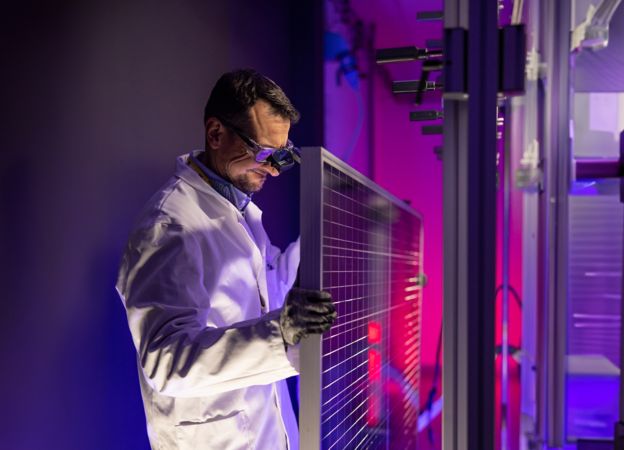
Energie rinnovabili
Nuove tecnologie per ottenere energie sostenibili da sole e vento.

Oppure , la nostra nuova soluzione di intelligenza artificiale.
Oppure , la nostra nuova soluzione di intelligenza artificiale.
La tecnologia è la chiave della decarbonizzazione. Per questo è alla base della nostra strategia.
Amministratore Delegato di Eni

Sviluppiamo tecnologie per la transizione con l’obiettivo di accelerare la trasformazione aziendale e proseguire nel percorso di decarbonizzazione, grazie alle competenze dei nostri Centri di Ricerca in Italia e a una rete di collaborazioni per l’innovazione a livello globale.
Seguiamo tutte le fasi dell'innovazione tecnologica, dalla ricerca di nuove soluzioni allo sviluppo di impianti pilota fino all’applicazione su scala industriale di quelle tecnologie che hanno superato tutti i test, dimostrandosi le più efficienti.
Sviluppare nuove soluzioni tecnologiche è una scelta imprescindibile per il raggiungimento degli obiettivi Net Zero, che al tempo stesso ci permette di mantenere una leadership tecnologica per essere competitivi e creare valore sul lungo termine.

Nuove tecnologie per ottenere energie sostenibili da sole e vento.

Tecnologie proprietarie per biocarburanti di qualità che rendono la mobilità sempre più sostenibile.

Tecnologie e processi per ricavare nuovi prodotti e materiali utilizzando materie prime di origine vegetale e rifiuti plastici.

Tecnologia e processi innovativi per catturare e stoccare la CO₂ che può essere in parte utilizzata in altri settori industriali come l’edilizia.
Mentre sviluppiamo soluzioni per accelerare la transizione energetica, continuiamo a investire nell’eccellenza esplorativa sviluppando tecnologie di studio e caratterizzazione sempre più performanti e meno invasive per sviluppare asset sempre più complessi
La potenza di calcolo dei supercomputer, unita alle competenze di geologi e ingegneri, è il segreto dei nostri successi nell’esplorazione geofisica.

Miglioriamo le nostre attività nel settore energetico grazie ai nostri supercomputer e all’applicazione della IA a favore della decarbonizzazione.

Investendo in tecnologie esplorative d’avanguardia, acquisiamo una conoscenza del sottosuolo sempre più approfondita.
Nei nostri laboratori mettiamo a punto soluzioni specifiche per recuperare il suolo e le falde sotterranee di aree industriali. Una volta sviluppate e testate con successo, le applichiamo direttamente nei nostri siti produttivi o nei siti di altre aziende in cui operiamo attraverso Eni Rewind.
Secondo il principio della neutralità tecnologica, non esiste una soluzione unica per realizzare la transizione energetica ma è necessario disporre di un mix tecnologico adattabile ad applicazioni ed esigenze diverse. Per questo sviluppiamo un’ampia gamma di tecnologie che sostengano la decarbonizzazione di ciascun settore dell’economia e della nostra vita quotidiana.
I servizi e i prodotti di Eni si rivolgono a una pluralità di settori e di mercati, ognuno dei quali ha bisogno di un approccio specifico per la riduzione delle emissioni. Attraverso la messa a sistema di tecnologie avanzate, digitalizzazione e contributi dall’Open Innovation, sosteniamo sia i processi industriali sia i clienti finali, occupandoci dell’intero ciclo di vita di un prodotto, dall’approvvigionamento delle materie prime, alla produzione fino al suo utilizzo finale.
Questa tecnologia rappresenta una prospettiva concreta per una transizione energetica sicura e basata su una fonte virtualmente inesauribile.

Le maggiori scoperte scientifiche internazionali per la ricerca e l’innovazione tecnologica nel settore. Scopri lo speciale interattivo.


Se desideri cambiare argomento, svuota la chat ed effettua una nuova richiesta per ottenere risultati più pertinenti.
Questa azione comporterà l'eliminazione di tutte le domande fatte durante la fase di navigazione.
Con questa azione cancellerai ogni ricerca effettuata durante questa sessione di navigazione.
Qui puoi trovare la lista di tutte le tue richieste.
Le risposte sono generate dall'intelligenza artificiale, pertanto potrebbero contenere imprecisioni. Leggi i termini e condizioni di utilizzo

EnergIA è uno strumento innovativo basato sulle capacità dell’intelligenza artificiale, che può aiutarti a navigare tra i contenuti di eni.com, trovando subito la risposta alle tue domande. EnergIA può effettuare una ricerca su un tema specifico, fornendo i dati più aggiornati disponibili, oppure può invitarti ad approfondire un argomento di tuo interesse. Inizia subito!
EnergIA è uno strumento innovativo basato sulle capacità dell’intelligenza artificiale, che può aiutarti a navigare tra i contenuti di eni.com, trovando subito la risposta alle tue domande. Inizia ora!
EnergIA è un sistema basato sull’Intelligenza Artificiale Generativa.
Grazie a questa tecnologia riusciamo a rispondere alle tue richieste interrogando i contenuti e i documenti più rilevanti presenti su eni.com. (N.B. Vengono presi in considerazione i documenti finanziari degli ultimi 12 mesi e i comunicati stampa degli ultimi 2 anni.)
Attraverso EnergIA puoi approfondire le tematiche di tuo interesse e avere una finestra in tempo reale sul mondo Eni.
Se desideri, invece, cercare uno specifico documento, comunicato stampa o news, utilizza il motore di ricerca tradizionale tramite icona della lente.
Come tutti i sistemi che sfruttano l’Intelligenza Artificiale Generativa, EnergIA potrebbe generare risposte inesatte o non aggiornate. Ti invitiamo sempre a consultare le fonti che il sistema indica come origine dell’informazione generata.
In alcuni casi, in assenza di una perfetta corrispondenza con la richiesta, il sistema cerca comunque di fornire una risposta.
Qualora dovessi riscontrare delle inesattezze nella risposta fornita, ti preghiamo di segnalarcelo tramite il feedback disponibile a fondo pagina: ci sarà molto utile per migliorare.
Dal momento che quanto elaborato dal sistema non rappresenta la posizione ufficiale di Eni, invitiamo gli stakeholder interessati a conoscere le posizioni della Società a rivolgersi ai propri contatti di riferimento: Ufficio Stampa per i giornalisti, Investor Relations per analisti e investitori, Segreteria Societaria per gli azionisti etc..
EnergIA riesce a comprendere domande poste in quasi tutte le lingue, ma preferiamo fornirti una risposta in inglese o in italiano, le due lingue disponibili su eni.com.
Se poni una domanda in lingua italiana, saranno consultati i contenuti presenti sul sito in lingua italiana. Se la poni in inglese o in qualsiasi altra lingua, saranno consultati i contenuti in lingua inglese. (N.B. La lingua che Eni utilizza per i documenti/contenuti di carattere finanziario è prevalentemente l’inglese.)
Nel caso in cui vengano formulate domande che violino i criteri di sicurezza impostati, il sistema non procederà con l'elaborazione della risposta. Infine, ti chiediamo di non inviare dati personali.
Utilizzando questo servizio, l’utente dichiara di aver letto e accettato i termini e condizioni di utilizzo.
Ricerca
EnergIA è un sistema basato sull’Intelligenza Artificiale Generativa.
Grazie a questa tecnologia riusciamo a rispondere alle tue richieste interrogando i contenuti e i documenti più rilevanti presenti su eni.com. (N.B. Vengono presi in considerazione i documenti finanziari degli ultimi 12 mesi e i comunicati stampa degli ultimi 2 anni.)
Attraverso EnergIA puoi approfondire le tematiche di tuo interesse e avere una finestra in tempo reale sul mondo Eni.
Se desideri, invece, cercare uno specifico documento, comunicato stampa o news, utilizza il motore di ricerca tradizionale tramite icona della lente.
Come tutti i sistemi che sfruttano l’Intelligenza Artificiale Generativa, EnergIA potrebbe generare risposte inesatte o non aggiornate. Ti invitiamo sempre a consultare le fonti che il sistema indica come origine dell’informazione generata.
In alcuni casi, in assenza di una perfetta corrispondenza con la richiesta, il sistema cerca comunque di fornire una risposta.
Qualora dovessi riscontrare delle inesattezze nella risposta fornita, ti preghiamo di segnalarcelo tramite il feedback disponibile a fondo pagina: ci sarà molto utile per migliorare.
Dal momento che quanto elaborato dal sistema non rappresenta la posizione ufficiale di Eni, invitiamo gli stakeholder interessati a conoscere le posizioni della Società a rivolgersi ai propri contatti di riferimento: Ufficio Stampa per i giornalisti, Investor Relations per analisti e investitori, Segreteria Societaria per gli azionisti etc..
EnergIA riesce a comprendere domande poste in quasi tutte le lingue, ma preferiamo fornirti una risposta in inglese o in italiano, le due lingue disponibili su eni.com.
Se poni una domanda in lingua italiana, saranno consultati i contenuti presenti sul sito in lingua italiana. Se la poni in inglese o in qualsiasi altra lingua, saranno consultati i contenuti in lingua inglese. (N.B. La lingua che Eni utilizza per i documenti/contenuti di carattere finanziario è prevalentemente l’inglese.)
Nel caso in cui vengano formulate domande che violino i criteri di sicurezza impostati, il sistema non procederà con l'elaborazione della risposta. Infine, ti chiediamo di non inviare dati personali.
Utilizzando questo servizio, l’utente dichiara di aver letto e accettato i termini e condizioni di utilizzo.
Una nuova finestra sul mondo Eni, a tua disposizione. EnergIA è uno strumento innovativo basato sulle capacità dell’intelligenza artificiale, che può aiutarti a navigare tra i contenuti di eni.com, trovando subito la risposta alle tue domande.


